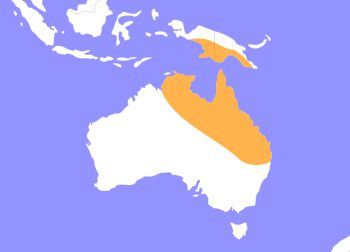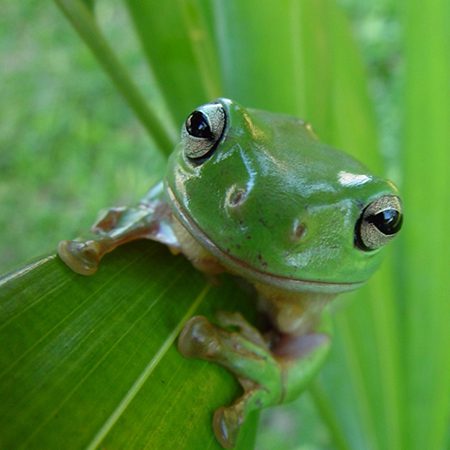White's Dumpy Tree Frog
Ranoidea caerulea
Sometimes known as just the White’s tree frog or Dumpy tree frog, these frogs are native to northern and eastern Australia as well as New Guinea. They are generally green in color with white underbellies and can have spots of white or gold on their back and sides. They will also turn brown depending on mood, health, weather, etc. Tree frogs are very good climbers; their hands are adapted to be able to stick to pretty much any surface. They have big yellow/golden eyes with horizontal oval-shaped pupils and a black ring around the edge of the eye. These frogs are about 4-5 inches long, with males being bigger than females, and can live over 20 years. The average lifespan, however, is just 7-10. Like many other frogs, they have little defense mechanisms other than camouflage and powerful leaps.
Frogs are known as indicator species, meaning that when there is a change in the habitat, they are likely to respond first. This is most important with chemical changes, such as pollution. Because of their absorbent skin, amphibians can more easily take in these chemicals, as compared to mammals, and will be affected more. These effects are never positive and must be watched carefully as a species may start to die off. Many frog species have also been struggling with a fungus called Chytrid, that has sent several species to extinction already.
Say Hello To Cub Creek's Frogs: Humpty & Dumpty
Our White’s Tree Frogs, Humpty & Dumpty, came to camp in January of 2019 and live in the Creepy Crawly Room with our Millipedes, Crested Geckos, and more! They live together in a terrarium where they love to climb their branches or sit in their water bowl. Their favorite foods are crickets and worms and love to chase down their food.

White’s Dumpy Tree Frogs are native to Australia, and New Guinea.
HABITAT -They live in the coastal areas of northeastern Australia and New Guinea.
DIET -Insectivorous, they will eat insects, spiders, and other invertebrates.
FUN FACT -They get the name dumpy because of the fat deposits above their eyes.
SOCIAL BEHAVIOR -They are friendly to people and each other.
ACTIVITY -These frogs are nocturnal, being active most at night.
PREDATORS -Their predators include snakes, large lizards, and birds.
SIZE -They can grow to be 4-5 in in length, with males being larger than females.
RELATIVES -Other species in the Ranoidea genus are the Giant Frog and the Green and Golden Bell Frog.
CONSERVATION -They are considered Least Concern under the IUCN.
Cub Creek Animal Care Information
Housing - In the summer, our frogs can be found in the Creepy Crawly Room, but in the off season they live in the Cat Room. Our frogs live in their own terrarium together. The bottom is covered in sphagnum moss and they are given access to fresh water along with branches and artificial plants they can climb, hide in, and explore. Their entire enclosure is sprayed with water multiple times a day to simulate their natural, humid rainforest environment.
Diet - Live insects or invertebrates are the main components of our frog’s diet. They are given mealworms, beetles, worms, and crickets on our reptile feeding schedule, meaning they are fed on Mondays, Tuesday, Thursdays, and Saturdays. These small animals do not need to be fed every day if they are fed an adequate amount at each feeding.
Enrichment - Frogs do not need much enrichment beyond how their enclosure is set up. In the summer, our campers do have the opportunity to handle them, so they get stimulation through interactions. Feeding them live invertebrates is also a form of enrichment because they have to chase down their food.

